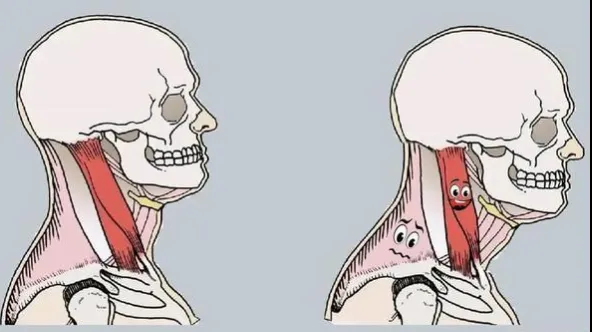How To Correct Anterior Neck Tilt?
Today's lifestyle habits cause us to often do things with our heads down (such as looking down at our phones) or habitually lean forward to look at the computer. Such a habit causes our shoulders to lean forward and arch behind our backs. Head forward tilt not only affects posture, but also makes people look less confident and can cause cervical pain. In this article, we teach you how to improve the problem of forward neck tilt.

How To Self-Test Head Forward Tilt?
First, let's do a simple test to see if you also have a head tilt forward. Ask the person next to you to look at the side while you are relaxed to see if your earlobe and acromion are on the same vertical line. If it's on the same vertical line, it's fine, otherwise it's likely to tip your head forward.
What's Going On With Your Head Leaning Forward?
In daily life, we are always used to looking down at the screen. Especially office white-collar workers, always unconsciously, look forward. It can be seen that in this posture, the muscles around our neck have changed to varying degrees.
Among them, the posterior cervical muscles are forced to lengthen, and they have to use the strength to eat milk in order to pull the head that stretches forward; The muscles on the front side shrank up and took the opportunity to "be lazy". In fact, as soon as many people sit down, they will not change their posture for less than 1~2 hours, just like the old monk. Over time, some of the neck muscles become tight and stiff, while others become weak and weak. More seriously, once they adapt to such a "behavior pattern", even on weekdays, we will habitually poke our necks forward, otherwise we will feel uncomfortable. This is how the bad posture of leaning the head forward is formed.
What Is The Harm Of Tilting Your Head Forward?
Tilting the head forward is common in people who often work on the computer, sit for a long time, and play with their heads down with their mobile phones. It will make your neck visually shorter and lose a lot of temperament.
In general, head forward tilting will disrupt the balance of our shoulder and back muscles, so it is usually accompanied by problems such as round-shouldered hunchback. Moreover, in a forward-tilted posture, the cervical spine is abnormally positioned, which increases the pressure between the vertebral bodies.
In the long run, it may cause changes in the curvature of the cervical spine, resulting in neck and shoulder pain, arm numbness and other symptoms.
How To Correct The Forward Tilt Of The Head?
For simple muscle imbalance, tilting the head forward, allowing the anterior muscles to contract, the posterior muscles to be over-lengthened, and the imbalance of the anterior and posterior muscles will inevitably lead to changes in the skeleton structure of the body. Therefore, to correct this bad posture, we must start by balancing muscle strength to relieve the pressure on the joints. First of all, it is necessary to correct the wrong movement posture and consciously move the head back forward. Secondly, carry out targeted correction training to relax tense muscles, exercise weak muscle groups, and return these problematic muscle groups to normal.
1) Trapezius Muscle Stretching
Movement essentials: Sit, hold the left side of the head with your right hand, and bend to the right to the maximum; Hold as you inhale, and sink your left shoulder as much as possible when you exhale; Feel the pull of the trapezius muscles, 5 breaths/set, repeat 4 sets, switch to the other side.
2) Trapezius Muscle Release
Action instructions: sit in a sitting position, place the small fascial ball in the fossa of the right clavicle with the left hand; Press the ball slightly with your fingers, roll it up, down, left and right; Feel the swelling of the scalene muscles, hold for 20s, repeat 4 times, and change to the other side.
3) Chin Retraction Training – Enhanced Version
The above training movements can help correct the forward tilting posture of the head to a certain extent!
In fact, in addition to simple muscle imbalance, there is a common situation that can also cause the head to tilt forward, that is, "kyphosis", which is also a common hunchback.
As shown in the figure below, when the thoracic vertebrae arches back, the cervical spine and head also follow suit, showing a forward posture.
Important: There are many causes of low back pain, and professional assessment + targeted rehabilitation training is the safest and most efficient rehabilitation method. It is recommended to go to a general hospital or specialized rehabilitation institution and find a doctor or rehabilitation therapist to customize a rehabilitation plan for you!
